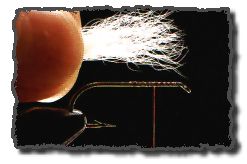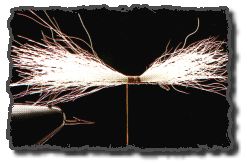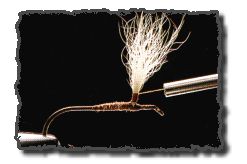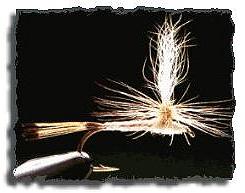Our thanks to Cowles Creative Publishing for permission to use photos and excerpts from
The Art Of Fly Tying
|
This weeks fly, the Pink Lady is a good light-toned dry fly, usuable for many situations. It is tied
as a parachute and will serve as an emerger and and dry since it rides "in" the surface film, not just on
top of it. Use it during the difficult period when some trout are taking emergers and some are taking
dries. A good all-around general purpose fly to have in the fly box in more than one size.
If you have not yet mastered the parachute dry fly, this is a good one to start with. It
is not a difficult method, and once learned will last you a lifetime. The silver ribbing is
optional, but I believe it is better on than left off.
|
 |
Hook: Standard dry fly, Size 10-18.
Thread: Cream.
Tail: Golden Pheasant Tippet.
Body: Antron, pink, and cream.
Rib: Silver tinsel.
Wing: White calf tail.
Hackle: Cream
|
Tying Instructions:
1. Start thread mid-body, wind back to bend.
2. Tie in pheasant tippets, ribbing, and antron body material.
3. Wind thread forward to wing position.
4. Select a small bundle of calf tail hair. Measure the material so the wing height equals hook-shank
length.

5. Tie in the bundle with tips facing forward, as you would an upright-and-divided wing.

6. Trim the butt ends and wind thread over them to form a tapered base for the body.
7. Set wing upright with several turns of thread arund hook shank in front of wing.

8. Wind thread horizontally around upright wing to form a short base for hackle.

9. Tie in hackle and turn around parachute post, tie off hackle.
10. Wrap pink antron forward, cover with ribbing.
11. Tie in cream antron, wind to eye and finish fly
 Tying Tips
Tying Tips
Cut the barbles off the sides of the hackle feather, do not 'strip' them off. The first turns of thread
over the hackle stem should not be too tight as this may fracture the feather and cause it to break; if
not now, in the future. A dab of cement on the parachute post may be desired after step #8. Many
materials can be used for a parachute post; calf tail, hackle tips, duck flank feathers, and synthetics.
Try bright colors for small flies and low light conditions.-JC
|
|






